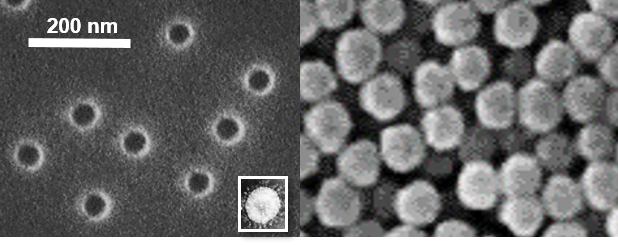Filtering the corona virus out of waste water
Professor Wolfgang Ensinger is carrying out research into nanopore membranes
2020/04/20
Professor Wolfgang Ensinger and his working group in the Department of Materials and Earth Sciences have been working together with the GSI Helmholtz Centre for Heavy Ion Research for many years on the production and use of nanopores in plastic film. Nanopore membranes are also suitable for filtering and separating purposes – and can thus be used to filter the coronavirus out of waste water.

While the working group are currently focussing on research into nanopore-based sensors for biomolecules, such as for medical diagnoses (LOEWE Research Cluster iNAPO and the Centre for Synthetic Biology), research was previously carried out into the use of nanopore membranes for filtering and separating purposes. Applications included enriching organic molecules and gas molecules in mixtures and separating particles from solutions, e.g. blood cells from blood, aerosol particles trapped in liquids or even floating particles in drinks.
Using the ion track-etching process, pores can be created in the film with diameters in the micrometre range down to the nanometre range. It is conceivable that diameters in the nanometre range could also be used to filter out viruses – such as the current coronavirus.

These filters could be used to detect coronaviruses in waste water – a strategy proposed by epidemiologists, virologists and politicians for determining the local dissemination of a virus and thus deriving appropriate lockdown strategies. To simulate the filterability of the virus through the nanopore membranes, Ensinger and his working group used spherical particles made of silica and polystyrene with a diameter of 140 nm. The coronavirus virons, in other words the virus particles, have a diameter of between 120 and 160 nm. If the diameter of the nanopores is significantly smaller than that of the virus, a very high filtration efficiency can be expected. It is important to note in the simulations that the particles made out of silica and polystyrene are very rigid, while the lipid membrane of a virus envelope has a certain level of flexibility. It is possible to prevent the virus from simply slipping through by selecting a significantly smaller diameter for the nanopores.
However: A smaller nanopore diameter will result in lower filter throughput. This can be counteracted by creating a larger number of nanopores but this solution also has its limits. The nanopores created in the plastic film are randomly distributed across the surface. As the surface density increases, there will be more and more overlapping nanopores, which are larger and allow more of the virus particles to slip though.
The ion track-etching method used on polymer films has a series of special benefits: The films have a thicknesses of a few 10 µm and are therefore stable and very easy to handle for technical purposes. They also have a certain level of flexibility, meaning that they are not brittle and thus at risk of breaking as is the case with ceramic materials. This also means that the films can withstand a certain level of pressure caused by the liquid being filtered as it passes through them. The especially resistant plastic polyimide is also one of the most stable grades of polymer from a thermal, chemical and radioactive chemical perspective. The material is thus not damaged by sterilisation measures. In contrast to most other membrane and filter materials, nanopore membranes also have a very narrow pore diameter distribution. This guarantees the high filtering efficiency for viruses.
The nanopore-based sensors, which have already been developed for biomolecules in the LOEWE Research Cluster iNAPO, will also be used for research into SARS-CoV-2. The aim is to cooperate with virologists at neighbouring universities in the State of Hesse.
Professor Wolfgang Ensinger/mho
Focus "Fighting Corona"
Researchers, students and employees at the university are responding to the current corona crisis in a variety of ways. The focus provides an up-to-date overview of the numerous aid initiatives and projects in research, teaching and transfer.

